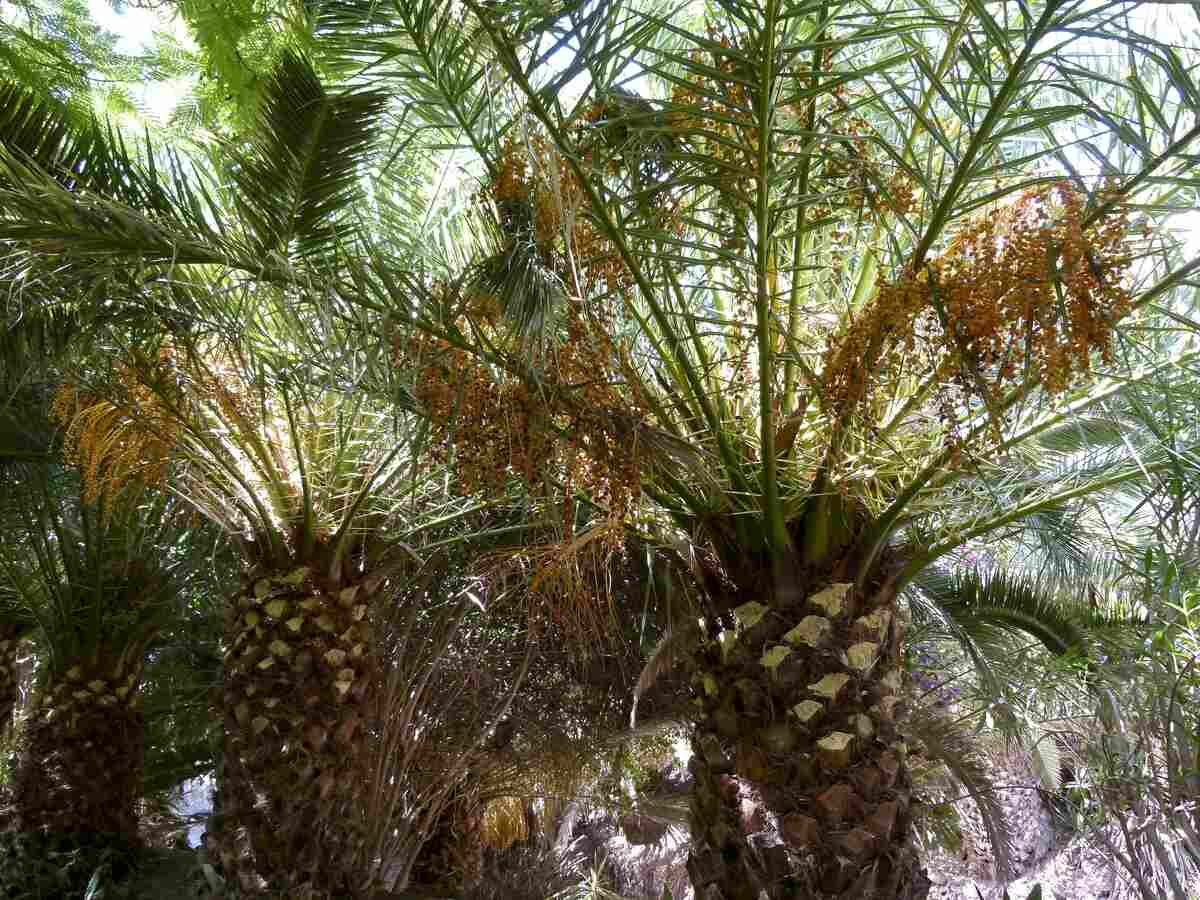
Just like a lot of the people, palm trees migrated to Phoenix — and are flourishing. So much so that it can be overwhelming to decide which trees to plant in your yard. To help you with this decision, here are the seven best palm trees to plant in Phoenix.
As common as palm trees are in Phoenix, you would think that they are native to Arizona – at least a few of them, right? Even the Latin names of several species of palm trees include the word “Phoenix.”
Surprisingly, for nearly all the palm trees in Phoenix, the answer is no, they’re not natives. The Washington filifera (also known as the California fan palm, petticoat palm, or desert palm) is truly a native palm tree. And it can only be found on the Kofa National Wildlife Refuge.
Types of Palms
Phoenix is perfect for palm trees because many are made for dry, hot climates with an average winter temperature between 25 to 35 degrees Fahrenheit. This puts Phoenix in the USDA Hardiness zones of 9b and 10a.
Choosing which of the more than 2,500 species of palm trees to plant can be a little challenging.
Based on leaf shape, we’ve broken up the list into two types of palms.
- Feather palms: Have pinnate leaves — a leaf with smaller leaflets positioned on either side of the stem in the middle of the fronds, like a feather.
- Fan palms: Have palmate leaves — a leaf with segments extending from a central point and resembling an open hand or fan.
When choosing a palm tree, consider the following factors: Height and spread at maturity, upkeep, property size, any nearby structures, soil quality, and availability of sunlight and water.
If you want that Phoenix feel but live in a cooler climate there are several cold-hardy palm trees to choose from.
Feather Palms
Queen Palm (Syagrus romanzoffiana)
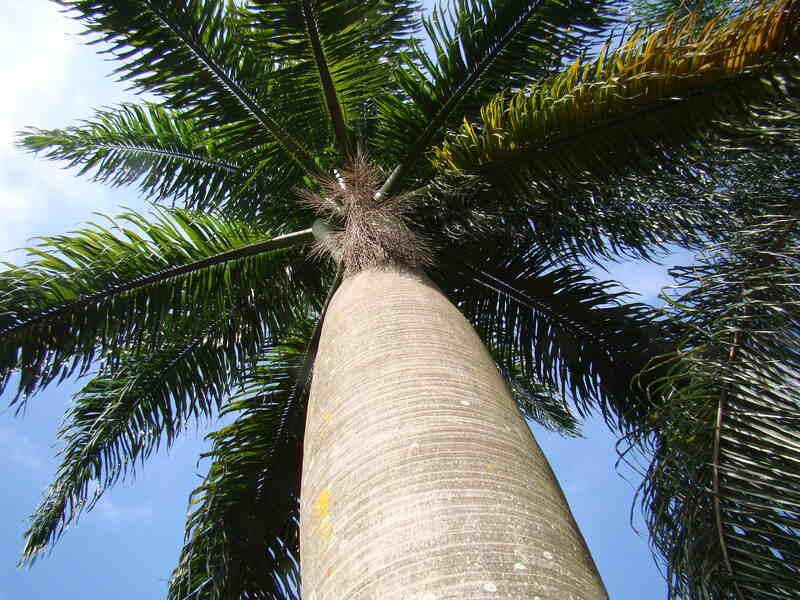
Photo Credit: mauro halpern / Flickr / CC BY 2.0
Queen Palms give pools, home gardens, and huge courtyards a luxurious, tropical atmosphere. Syagrus romanzoffiana is a favorite choice in Phoenix because of its year-round majestic appearance and long, vibrant green fronds.
Syagrus romanzoffiana can thrive in a range of environments and make a fantastic addition to landscape designs. Once they reach a great height, you’ll need to hire a professional to prune the queen palm trees’ tops.
Ideal for: Parks, lining streets, pools, and expansive commercial and residential properties. Keep in mind the flowers and fruit can fall off at maturity and pile up in the area and are considered a bit messy.
Flowers/Fruit: In the summer, plumes of creamy white blooms bloom, and in the winter, trailing clusters of orange fruits appear.
Foliage: The fluffy, glossy green fronds can grow to be up to 15 feet long. As the fronds age and die, they may turn yellow or brown.
Growth rate: Moderately fast — can grow 2 to 6 feet a year
- Hardiness zone: Hardy in zones 9b to 11
- Sun tolerance: Full sun or part shade
- Drought tolerance: Moderate once established
- Soil type: Prefers sandy, acidic, and well-drained soil
- Mature Height: Can reach up to 40 feet
- Mature Spread: Reaches 15 to 30 feet wide
- Mature Trunk: About 1.5 to 2 feet wide
- Water Needs: Medium to high
Grower’s Notes: Syagrus romanzoffiana flourishes with nitrogen fertilizer, extra iron to prevent chlorosis, and plenty of water. Queen palms need regular watering, with extra care when plants are young. Planting in wind-protected areas can help decrease damage.
Canary Island Date Palm (Phoenix canariensis)
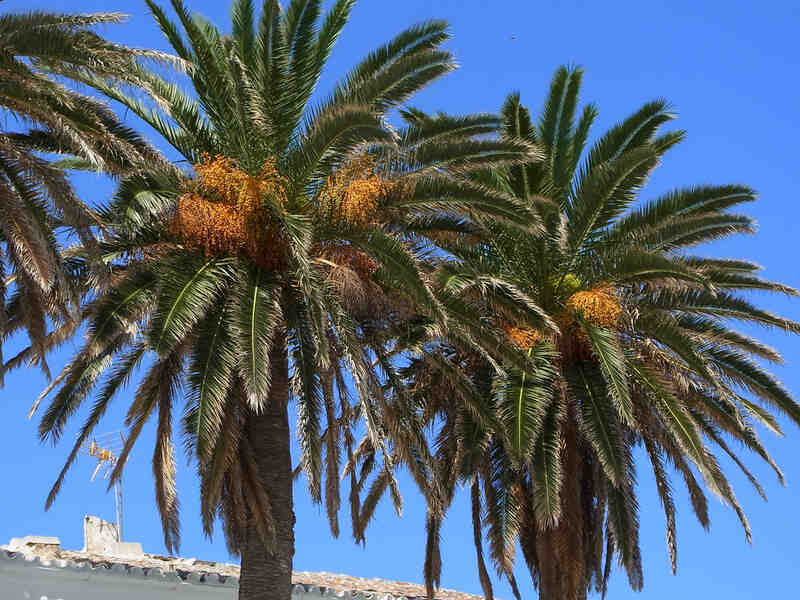
Photo Credit: Donkey shot / Wikimedia Commons / CC BY-SA 3.0
A date palm that grows well in Phoenix is the Phoenix canariensis, also known as the Canary Island date palm or pineapple palm.
The beautiful Canary Island date palm is a sizable feather palm (up to 50 feet tall) with a broad spread. Long and arching, glossy, dark green fronds with orange midribs give the crown a fountain-like look.
And like a true date palm tree, Phoenix canariensis does produce fruit, but the fruit from this palm tree is more ornamental. Technically, you could eat it, but you probably won’t want to.
Ideal for: Large commercial and home landscapes, parks, and along avenues. Young trees make attractive and easy-to-care-for container plants.
Flowers/Fruit: Panicle flowers have a creamy-yellow color and can grow up to 4 feet long. Flowers in female plants transform into clusters of reddish-yellow dates.
Foliage: Rich, evergreen feather-like pinnate leaves up to 15 feet long.
Growth rate: Slow — about 1 foot a year
- Hardiness zone: Hardy in zones 9 to 11
- Sun tolerance: Full sun; part shade tolerant
- Drought tolerance: Good when well-established
- Soil type: Slightly acidic, well-drained, organic-rich
- Mature Height: 40 to 50 feet
- Mature Spread: 20 to 40 feet
- Mature Trunk: 3 to 4 feet wide
- Water Needs: Low to moderate once established
Grower’s Notes: Speed up growth with regular, deep irrigation and fertilizing. For the best look, prune regularly. Phoenix canariensis has a well-known tolerance for salt and drought conditions.
Pygmy Date Palm (Phoenix roebelenii)
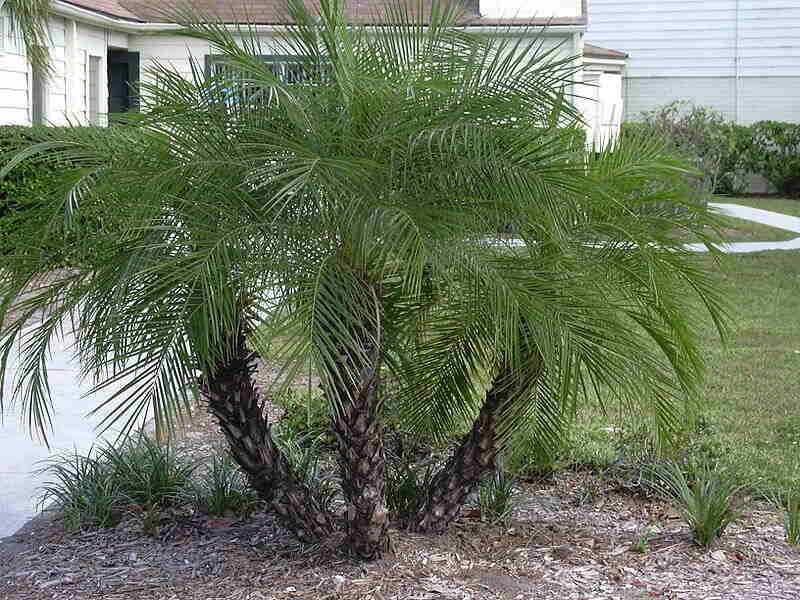
Photo Credit: Forest & Kim Starr / Wikimedia Commons / CC BY 3.0
If you like the look of date palms, but don’t have room for a large Canary Island variation, consider the pygmy date palm. This one has a very similar look, but its trunk rarely gets bigger than 10 feet.
Native to Southeast Asia, the Phoenix roebelenii can add an elegant look to your lawn without taking up too much space. A dense, beautiful crown forms on a single or multi stemmed, straight or curved trunk. The arching, finely cut, dark evergreen leaves give this plant a delicate, polished look.
Ideal for: It works perfectly for container gardens, sheltered areas, and as a houseplant.
Flowers/Fruit: On female trees, the cream-colored blossoms grow into edible date clusters.
Foliage: This palm grows arching, elegant fronds up to 3+ feet long with tiny leaflets.
Growth rate: Slow — 3 to 4 inches a year.
- Hardiness zone: Hardy in zones 9 to 11
- Sun tolerance: Part shade to full sun
- Drought tolerance: Moderate
- Soil type: Prefers sandy, well-drained soil. Tolerates some clay or loam as long as it drains well.
- Mature Height: From 6 to 10 feet, smaller if grown indoors
- Mature Spread: About 3 to 5 feet wide
- Mature Trunk: Slender, usually planted in clusters
- Water Needs: Moderate; prefers lightly moist, not soggy, well-drained soil during the growing season
Grower’s Notes: Remove dead or damaged leaves when needed. Wear gloves to avoid the sharp spines at the bottom of the pygmy date palm leaflets. Consistent irrigation and nitrogen fertilizer application encourage robust and healthy development.
Fan Palms
Mexican Blue Palm (Brahea armata)
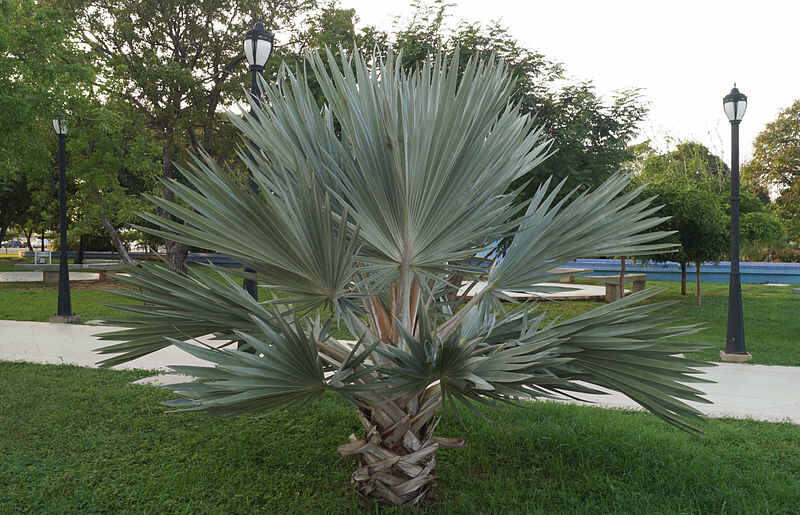
Photo Credit: Rjcastillo / Wikimedia Commons / CC BY-SA 3.0
Brahea armata has a broad, straight single trunk, thicker at the base and topped with a magnificent crown of pointed fan-shaped leaves in frosty blues and greens. With leaves measuring 6 to 8 feet wide and 3 to 4 feet long, the leaf stalks, or petioles, can reach lengths of 5 feet.
The Mexican blue palm is a stunning native of the Baja Peninsula. Brahea armata can tolerate extreme heat and dryness while remaining a cold hardy palm, making it a great choice for tough desert conditions where other palms may struggle. The pretty blue leaves contrast nicely with desert plants.
Ideal for: As a landscaping palm, in a Mediterranean-inspired landscape, or in a container garden.
Flowers/Fruit: Softly aromatic, milky white flowers arranged on stalks up to 18 feet long.
Foliage: Silver-blue, waxy leaves arch gracefully from an upright columnar trunk.
Growth rate: Very slow — grows between 3-5 inches a year.
- Hardiness zone: Hardy in zones 9 to 11
- Sun tolerance: Full sun
- Drought tolerance: High
- Soil type: Well-drained soil of most types
- Mature Height: From 25 to 30 feet
- Mature Spread: Between 6 to 10 feet
- Mature Trunk: Averages 3 feet or more
- Water Needs: Low to medium; water once a month
Grower’s Notes: Tolerates extremes of heat, cold, wind, and a variety of growing environments. Cut off dead fronds that have folded down to the trunk. If old growth is not removed, Brahea armata will develop a shaggy skirt.
Mediterranean Fan Palm (Chamaerops humilis)
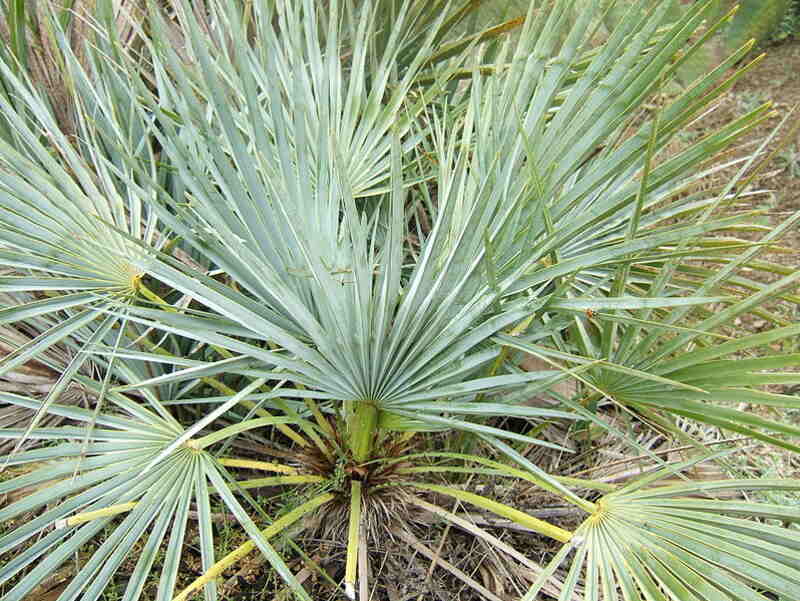
Of all palms, the slow-growing Chamaerops humilis is among the most cold hardy. Leaflets that range in color from blue to gray-green are rigid and make up the fronds’ fan form. At the end of each curved stem, these finally consolidate into a dense crown.
The Mediterranean fan palm is also known as the “European fan palm” since it is the only palm tree native to Europe. The bushy, multi trunked variety of the highly diverse Chamaerops humilis is a popular choice in Phoenix because it thrives here.
Ideal for: Creates a lovely privacy screen or group highlight in a corner. Use in containers for foundation, patio, or deck areas. Even indoor growing is an option.
Flowers/Fruit: Springtime brings the appearance of bright yellow blooms, which are usually blocked from view by the stems of the leaves.
Foliage: Palmate-compound leaves that are enormous, triangular, and finely textured. Each leaf ranges from pale blue-green to silver-green up to 2 feet long and wide.
Growth rate: Slow — only about 6 inches a year
- Hardiness zone: Hardy in zones 8 to 11
- Sun tolerance: Full sun, partial shade tolerant
- Drought tolerance: Medium to high once established
- Soil type: Prefers organically rich, moist, good drainage
- Mature Height: Between 5 to 15 feet
- Mature Spread: From 5 to 20 feet
- Mature Trunk: Clumping, stem suckers eventually result in grouping
- Water Needs: Moderate; water weekly or more often if in pots or during drought
Grower’s Notes: Sharp, needle-like spikes protect the stalks. Mediterranean fan palms can withstand a lot of neglect, but they thrive in rich soil and lots of water. Pruning will reduce the number of stems and remove defunct fronds.
Windmill Palm (Trachycarpus fortunei)
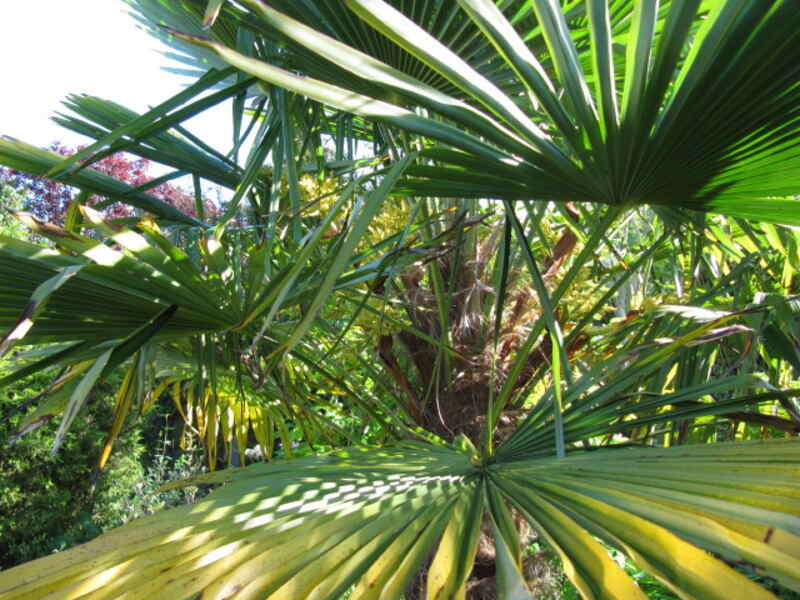
Photo Credit: Leonora (Ellie) Enking / Flickr / CC BY-SA 2.0
Trachycarpus fortunei is not only extremely tough for a palm, but it is also the ideal choice for smaller gardens. It begins as a foundation plant with a single, hairy trunk and matures into a tall, slender column with a tight crown of green foliage.
A compact, symmetrical crown with a windmill-like display of fan-shaped fronds. The straight, slender trunk of the windmill palm tapers from top to bottom. Old frond stumps peek out from under a thick coating of hairy, black fibers.
Ideal for: Small gardens, containers, pool areas, and rock gardens.
Flowers/Fruit: The golden yellow flowers bloom on drooping panicles that can grow up to 2 feet long. Dark blue drupes develop on female trees.
Foliage: Divided, fan-shaped evergreen leaves up to 3 feet long and wide. They have a waxy, gray layer on the underside.
Growth rate: Slow — grows less than 1 foot per year.
- Hardiness zone: Hardy in zones 7 to 11
- Sun tolerance: Full sun to part shade
- Drought tolerance: High
- Soil type: Tolerant of loam or sandy soil types with good drainage
- Mature Height: From 15 to 25 feet
- Mature Spread: Between 6 to 8 feet wide
- Mature Trunk: About 1 foot
- Water Needs: Medium to high. A young plant needs to be well-watered, but watering needs are reduced once established.
Grower’s Notes: Regular watering and fertilizer are beneficial. The windmill palm looks best when grown in the shade of bigger trees or on the east side of buildings, to protect it from the afternoon light. Prune periodically to keep a tidy look. A cold-hardy palm.
Guadalupe Fan Palm (Brahea edulis)
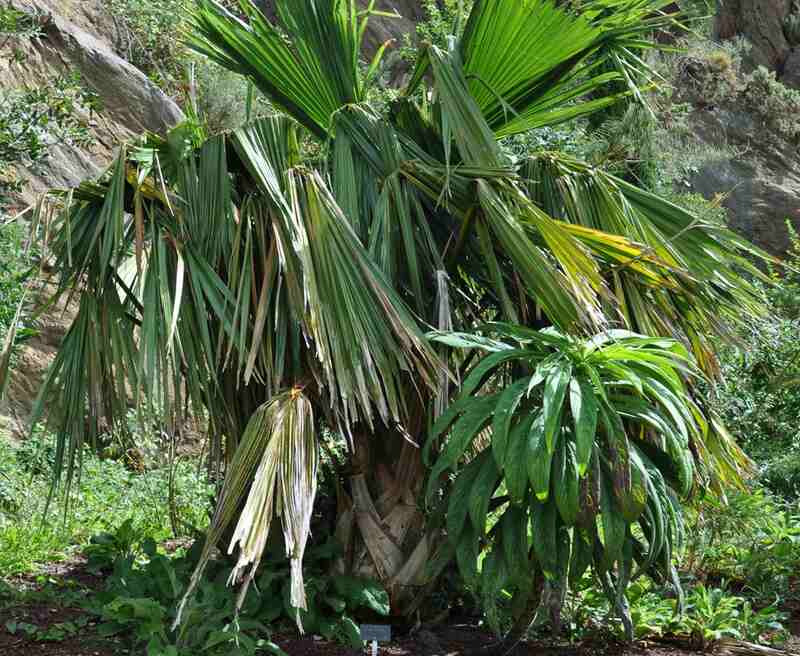
Photo Credit: Citron / Wikimedia Commons / CC BY-SA 3.0
Brahea edulis is a slow-growing, mid-sized palm native to Guadalupe Island off the west coast of Mexico. The Guadalupe fan palm is a sturdy, attractive tree comparable to the Mexican Blue Palm, but with faster growth and less visible blooms.
Guadalupe fan palms have a ringed, single robust trunk and light green fan-like fronds that add a tropical flair to any setting. Brahea edulis is a popular option throughout the Southwest. Its fruit has a similar flavor to dates and is frequently harvested to make preserves.
Ideal for: Group plantings, containers (when young), borders, and patios.
Flowers/Fruit: Small, yellow or white, fragrant flowers grow on stalks that are 4 to 5 feet long, and large clusters of small, delicious, black fruit follow.
Foliage: Large, medium-green fronds shed smoothly and don’t need pruning. They retain their color nicely over the winter.
Growth rate: Slow — about 1 foot per year
- Hardiness zone: Hardy in zones 9 to 11
- Sun tolerance: Partial shade to full sun
- Drought tolerance: High
- Soil type: Tolerant of poor, dry soil with good drainage
- Mature Height: Reaches 20 to 30 feet tall
- Mature Spread: From 8 to 10 feet wide
- Mature Trunk: About 2.5 to 3 feet wide
- Water Needs: Low; deep, occasional watering as needed
Grower’s Notes: Brahea edulis is very resistant to wind and salt. They do better in dry, subtropical climates than with high humidity. Guadalupe fan palms can flourish in nearly any soil type, require little to no maintenance once established, and only occasional watering. A cold-tolerant palm.
Transform your Phoenix home’s landscape into the tropical oasis that every desert dweller craves with a few palm trees.
Many More Choices
These are the seven best palm trees to plant in Phoenix, but they aren’t the only ones that thrive here. The Phoenix dactylifera and Phoenix rupicola are also good choices. And there are more.

If you are feeling overwhelmed by the options or just want more detailed information to help you select and plant palm trees, John Caravetta, the associate director of the Arizona Department of Agriculture had this to say:
“The best place for local advice and recommendations on plant material is your local retail nursery,” Caravetta says. “These operations have been in the Valley for many years and have a great deal of expertise in making recommendations on what works best for a particular landscape situation and our climate.” The U of A Cooperative Extension service in Maricopa County is also another great resource for the public.”
How Do You Take Care of Palm Trees?
To properly care for your palm tree, make sure it receives the right fertilizer and sufficient water.
You should apply a specialized palm fertilizer with the needed nutrients to sustain your healthy palm. Watering your palm on a consistent schedule, especially during the first couple of years after planting, is critical in Phoenix’s dry climate.
FAQ: Best Palm Trees to Plant in Phoenix
Yes! It is the perfect environment for these tropical plants due to the warm climate and desert soil. In Arizona, you will find many different kinds of palm trees. For more inspiration, check out How to Landscape With Palm Trees in Phoenix.
It varies, but when it gets hotter than 100 degrees, water deeply four to five times every week. It’s recommended to water plants slowly with a drip system or a soaker hose.
Your palm tree’s cost will vary depending on its species and height when you purchase it. Mature palm trees that are 10 to 20 feet tall can cost thousands, and the price differs based on the species.
Typically, smaller palms like the pygmy date palm cost between $50-$60 for a small, 2-3 gallon pot. You may spend as low as $25 on a small, fledgling palm, but keep in mind that it might take the plant many years to grow to the desired height for your landscape design.
When to Hire a Professional
If you’ve never planted a tree before, you might want to hire a professional Phoenix landscaper to do it for you. Palm trees, as you may have noticed, are not cheap. They reflect an investment, and you want your investment to live! In addition, professional landscapers may also assist you in developing a good care routine for your new palms.
LawnStarter participates in Get Sunday’s affiliate advertising program. LawnStarter may earn revenue from products promoted in this article.
Main Image Credit: Norbert Nagel, Mörfelden-Walldorf, Germany / Wikimedia Commons / CC BY-SA 3.0